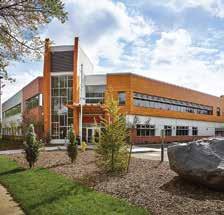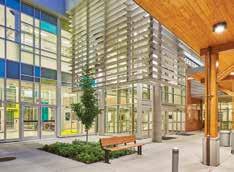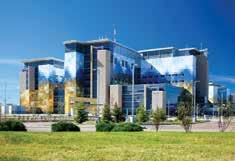
22 minute read
COMMUNITY CENTRES REDEFINED
by MediaEdge
How to socially distance in spaces charged for social interactions? This is just one challenge facing community centres as they prepare for reopening. A new perspective on design includes a hybrid of physical and virtual programming. Here, ZAS Architects’ Principal Peter Duckworth-Pilkington discusses the changing role of such facilities like Canoe Landing Campus—the firm’s new community centre/multi-school complex serving CityPlace.
HOW MIGHT A HYBRID MODEL OF PHYSICAL AND VIRTUAL PROGRAMMING INFORM THE FUTURE DESIGN OF COMMUNITY CENTRES?
Advertisement
Even before the lock down, there was more demand for remote and asynchronous access to programming. For example, it is difficult for most of us to commit to, say, a cooking class at the community centre every Wednesday night for 10 weeks due to work, family and other obligations. Yet studies have shown, and many of us have felt during this period of isolation, the value of physically getting together with others in a shared activity. Providing a hybrid model of physical and virtual programming, where a participant can have a high-quality experience either in the physical space or remotely, is an important offering to address this dichotomy. As we adjust to this ‘new normal,’ being able to extend the physical architectural space to the web will be critical to allow a diverse range of users to fully participate in community events, regardless of their individual obligations or location.
How can these social hubs encourage safe collaboration among varying groups—from a more senior population to young children who are unable to social distance properly?
Most community centre programming is scheduled and requires registration, whereby they can limit the numbers of participants and schedule the movement of people through a space. In fact, ‘drop-in’ programming may be limited or eliminated as a key method to reduce possible risk of contact and spread.
Programming for more vulnerable groups can be timed to avoid programming for those, like young children, who may have more trouble with physical distance. Beyond the programming methods, design interventions can also be integrated to limit the spread of the virus, including one-way circulation paths, distancing cues and signage, and no-touch light switches and door openers. We should also make better use of outdoor spaces, which have lower risk of transmission, including sports courts, rooftops and outdoor gathering and learning spaces. Toronto’s extreme climate has tended to compel activities indoors for much of the year but as designers and architects, we have an opportunity to embrace our four-season city and outdoor living through clever design interventions. This could mean placement of shelter elements to block winter winds and shade the summer sun or localised mist cooling or winter heating to mitigate extreme temperatures. It is important to remember that COVID-19 is a new disease and science’s understanding of its transmission is still evolving so it is critical that design responses remain agile and ready to adapt as new public health advice is disseminated.
WHAT ARE SOME CREATIVE SOLUTIONS FOR RETROFITTING OLDER FACILITIES?
The scheduling discussed above is an important measure that can be reasonably
BY REBECCA MELNYK
implemented in existing facilities. Design interventions are more challenging, however, signage and distance cues such as floor markings can be implemented. Installing automatic controls especially for lighting and plumbing fixtures are more expensive, but will often provide energy and water use savings that will offset costs, provide long-term environmental benefits and generate employment in this uncertain economy.
DO YOU THINK THESE PHYSICAL SPACES WILL MATTER EVEN MORE POST-PANDEMIC?
During this period of collective isolation, the necessity of community spaces has never felt more urgent. Even as the world has embraced remote ways of “gathering,” we have also realized their limitations. While virtual classes and meetings are convenient, and necessary in lockdown, the data shows that physically meeting in one place is still extremely valued by people from all demographics.
Yet, many people simply do not have the access to virtual programming, meaning a key function of community centre programming—providing equal access for all—is not being achieved through online offerings. Now, more than ever, civic facilities like Canoe Landing Campus are learning the benefits of physical, online, and hybrid programming options and understanding what type of programming is best suited to which modality. Going forward, I am hopeful that this newfound appreciation of public space will lead to further investment, a broadening of the kinds of programming being offered in community centres, and more flexibility to choose how we access this programming—be it in-person or from our computer at home. | CFM&D
BY MARCIA O’CONNOR
CLOSING THE SKILL GAP
Heading into COVID-19 lockdown in March ignited an unprecedented time for facility managers—changing them both professionally and personally.


Businesses had to react quickly— setting guidelines to ensure ongoing activities as well as the safety of their employees and customers. Facility managers’ core competencies, knowledge, strategic and tactical skills acquired during FM education and training have instinctively come into play for those working on-site or remotely. Facility


staff had to up their game—ensuring enhanced safety measures were in place to handle physical distancing and that security and sanitization aligned with different employee work hours and business hours of operation.
Potential weaknesses also surfaced along the way, some requiring attention as we move into workplace re-entry. As such, now is an opportune time to validate and/or assess a FMs expected skill set.
HARD SKILLS, SOFT SKILLS
Skill, the ability to do something well and to perform an activity in a competent manner, includes both hard (technical) and soft (habits or personality traits) expertise. Facility managers should first ask what skills need to be enhanced or improved, looking at situations that could have been handled differently or better.
FM hard skills were evident during the pandemic, ensuring that the continuous maintenance, safety and security measures were in place and/or implemented and in compliance with the Ontario Health and Safety Act (OHSA), and also crucial renovation and/or construction projects were proceeding that followed strict COVID-19 protocols.
FMs took the opportunity to rise up as leaders, overseeing the physical plant and employee and customer experience. Intuitively, these skills ramped up very quickly.
Lagging behind during the pandemic were soft skills, such as communication (oral or written), team work (group settings in the workplace to accomplish tasks quickly and effectively), adaptability and flexibility (related to embracing and rolling with change), and interpersonal skills (to interact and communicate with co-workers, management and customers).
LESSONS LEARNED ALONG THE WAY • Ongoing communication with management and staff is crucial during the pandemic. Changes in work routines—working from home and varying work hours— posed challenges for companies trying to stay abreast of the latest news and government directives.
Staying connected with current messages and directions about service expectations was an obstacle as the workforce moved homebound. The lack of technology, equipment and systems and family life hindered regular contact. Teamwork and collaboration required some new innovative ways to seek team input and ideas online (e.g. video conferencing) versus the traditional round table discussion at the workplace. Survival mode was a quick adjustment for many—remembering that not everyone is able to adapt to change quickly. Many were seeking out a process and guidance to make it through the pandemic. Interaction with co-workers was based on priority and regular communication was minimal. Social distancing placed restrictions for groups to gather face-to-face. The interaction
proved to be a stimulus for productivity and generating ideas.
Looking back, FMs should review what worked during the pandemic, what skills were missing or weaker than anticipated and any lessons learned to improve business operations. It is critical that FMs be part of a back-to-work strategy to voice their ideas, suggestions and areas for improvement that can all be applied going forward.
As we move into reopening, FMs are in high demand to ensure that buildings are safe for internal and external stakeholders. FMs need to take charge and remain strong—showing the key skills and knowledge FMs bring to various businesses.
Now is the time to shine— lifting companies up and into an unpredictable future in need of strategic leadership from FM professionals. | CFM&D
Marcia O’Connor is president of AM FM Consulting Group. She is also lead consultant and instructor for the University of Toronto’s facilities management certification program.

P R I M O P A V I N G . C A

A n n i v e r s a r y 1967 - 2017


CALL TODAY FOR A FREE QUOTE
ASPHALT PAVING

.CA

INTERLOCKING & LANDSCAPING
CONCRETE CURBING WINTER SERVICES
DURHAM REGION’S MOST REPUTABLE PAVERS Beware of Imitators & Fly-By-Nights!
1-800-30-PRIMO 7 7 4 6 6
416-748-7484 | PRIMOPAVING.CA
BOOK EARLY AND SAVE TAX *With C.O.D purchase only

See the Future in 3D Detail
Rendering and visualization technology brings architectural designs to life
By definition, visualization technology is a technique for creating images, diagrams, or animations to communicate a message. But in essence, it’s so much more. Since the dawn of humanity, visual imagery has been used as an effective means for sharing complex thoughts and ideas—hence the saying, “A picture is worth a thousand words.”
From cave paintings to hieroglyphs, Greek geometry to painted renderings, year-by-year our imaging capabilities are advancing at a startling rate. Today, it’s hard to imagine a time when handdrawn architectural sketches were the industry’s utmost tool.
“Visualization technology has given designers the ability to produce higher quality renderings far more quickly,” says Chris Febbraro, BIM Leader at RJC Engineers. “When changes occur to a project, they can be communicated faster and with more accuracy, making it more representative of an ever-evolving design. With BIM (Building Information Modelling), we are seeing that the model is alive and changing from week to week. This fluidity of design just wasn’t possible when we were putting drawings together by hand.”
LESS RISKS, MORE REWARDS
While visualization technology plays a huge role in early-stage communication, according to Febbraro, it goes well beyond that—even helping to shape the outcome of the physical structure itself.
“Just look at the development of the Toronto skyline today versus 40 years ago when buildings were more orthogonal,” he says. “Today we have complex organic façade systems stretching 90
storeys into the sky. This is a direct result of being able to design in a 3D workflow.”
Seeing the future in 3D detail minimizes the risk for stakeholders while potentially opening up some unexpected doors.
“Renderings put the client at ease,” he says. “Interactive visualization takes it one step further and puts them inside the building.”
Although 2D drawings for construction and legal purposes are still required by the industry, visualization technology makes design collaboration much more immersive. Moving to a 3D workflow improves the process of finding and documenting design issues and clashes, thereby improving overall efficiencies. And beyond that, they’re highly satisfying.
“I sometimes think that because we’re working with 3D models every day, we’re a little bit jaded on how cool this technology is,” says Febbraro. “When an owner sees a photo-real rendering or animation, or jumps into an interactive visualization, they get incredibly excited by it. That being said, there’s also money and time saved if an owner sees something they don’t like. It is far more costly when issues are caught after the building is finished.”
ACCURACY OF RENDERINGS
Given that no two projects or schedules are alike, Febbraro says the accuracy of renderings essentially comes down to individual project requirements and software choices. In other words, they can be highly accurate or they can be more rudimentary.
“It’s driven primarily by how quickly the renderings need to be produced and how much an owner is willing to spend,” he says. “As much as I would love to produce renderings to the highest quality and accuracy every time, it’s usually not practical and follows the law of diminishing returns.”
That said, Febbraro points out that visualization integration with Revit (BIM software) is making the point of dimensional accuracy moot. “As we’re putting together our construction documentation, we can take a kind of snap-shot of the work we’ve done so far,” he says. “Theoretically after we finish the Revit model, we should be able see the building dimensionally accurate to how it will be built.”
WHERE WILL THE TECHNOLOGY TAKE US NEXT?
As for what the future holds, Febbraro predicts Virtual Reality is the next evolution of visualization technology. “VR is developing and becoming more in-line with the value it’s providing,” he says. “The quality of this technology will continue to improve, with better hardware, higher resolution displays and further miniaturization of the devices. On the software side, we’ll see better integration with Revit and other BIM software packages.”
And we shouldn’t ignore other related technologies, like AR (Augmented Reality). “I see AR as just as valuable, albeit less immersive than VR,” he says. “The barriers to using the technology will diminish as it becomes easier to use.”
Meanwhile, clients looking for rendering and interactive visualization services today won’t be disappointed. “It’s not a very common thing to see a structural engineering company embrace visualization like RJC has. We hear time and time again from both the architects and owners we work with, that the level of service we offer is beyond what they’re used to seeing from other firms,” he says. “Overall, it’s well worth it.”
To find out how RJC’s visualization technology can benefit you, or to contact Chris Febbraro directly, visit: www.rjc.ca.

Design development rendering of RJC's glass canopy model at "The Well" in Toronto.
– Chris Febbraro, BIM Leader, RJC Engineers
BY PETER FARRELL
HANDS OFF

Going touch-free in a collaborative-yet-distant workplace
Shared spaces in facilities often mean sharing germs. Occupants tend to cluster in core areas of activity, such as washrooms and workspaces. As organizations prepare to welcome back employees and clients, many are eager to know how facilities will limit the risk of infection while supporting and inspiring social connections.
Arecent study revealed that 52 per cent of workers feel anxious about returning to work, feeling their facility has not done enough to mitigate risk. Research points out that COVID-19 can live on many surfaces for up to 72 hours, which means facility managers need to flag areas of virus transmission to protect the health of returning building occupants. They must also identify hot spots and understand how to make them touch-free through automation or disinfection.
Consumer demand for touch-free offices has been increasing over the past few years, most notably since the emergence of the coronavirus pandemic. The global touchless sensing market is projected to have a 22 per cent growth rate by 2027, valued at $65.9 billion US. In addition to limiting exposure to viruses and bacteria, touch-free technology offers reduced operating costs and increased user satisfaction. When it first emerged within facility management, it gained popularity in washrooms. Today, the technology expands throughout all areas of facilities and has a new focus on protecting occupant well-being by reducing surfaceto-person contact.
WASHROOMS
Cross-contamination is present on almost all surfaces throughout the washroom. Users transport bacteria from stalls and sinks and throughout the entire facility. Adding touch-free fixtures eliminates the need to touch common hot spots, like faucets, and reduces the chance of surface-to-person transmission. People use a variety of maneuvers to avoid contact with washroom fixtures. The following touch-free components will not only limit virus transmission risk but improve the overall hygiene of the washroom.
Toilet Seat Cleaner. A toilet seat typically houses 300 bacteria per square inch, putting people at risk for fecal-oral transmission and spreading fecal bacteria throughout the facility. Toilet seat cleaner effectively cleans the seat before each use, eliminating any bacteria that may be present as a result of previous flushes.
Personal Hygiene Disposal Unit. The old metal wall box commonly found in a public washroom is a major germ hotspot, containing bloodborne pathogens. COVID-19 has also been found to last 72 hours on stainless-steel. Implementing a touch-free disposal unit with a DINregistered dry treatment agent is the only solution to effectively minimize risks.
Toilet Flush Handles. Automatic flush systems eliminate surface-to-person contact while providing overall cost savings for high-traffic washrooms. When considering options to implement a touchfree washroom, facilities should consider renting the equipment as an alternative to buying. This allows managers to have a clear resource for any mechanical issues that may arise and provides facilities with the option to easily upgrade their equipment as new technology emerges.
Soap Dispensers. Occupants can track human-gut and skin-associated bacteria from the stall to the sink area, so soap dispensers will harbour the same bacteria. Automatic soap dispensers ensure hands are properly cleaned before leaving the washroom, dispensing a precise amount of soap.
They should be outfitted to use closedcartridge soap, as research suggests one quarter of refillable bulk soap dispensers are contaminated with bacteria.
WORKSPACES
Provincial governments have mandated efforts to limit virus exposure as employees return to work. Businesses are now providing employees with resources to reduce surface-to-person contact.
Disposing Personal Protective Equipment. The use of PPE is encouraged and even mandated in some areas where social distancing cannot be achieved. Employees who use PPE will first need to be trained on its use, care and safe disposal. PPE is often thrown into open garbage cans or treated as litter. The World Health Organization (WHO) recommends the use of a closed receptacle to avoid further contamination. Used PPE should be disposed of separately from regular waste and accompanied with educational signage to ensure proper removal and disposal.
Hand Sanitizer. The WHO recommends placing hand sanitizer dispensers in key, high traffic areas to promote proper hand hygiene, including elevator machine rooms, mechanical and electrical rooms and main janitorial rooms. Automatic dispensers release a precise amount of sanitizer each time while reducing risks of cross-contamination. They should have enough capacity so the sanitizing agent offers a constant flow during the day and be nimble enough to hold multiple brands in case of a supply crunch. Sanitizer services should also offer educational signage to promote a facility’s hygienic resources. When stockpiling sanitizer, be wary of the expiry date; shelf life can range between one and three years, depending on the product and storage methods.
Touch-Free Doors. Door handles, frequently touched items in facilities, create a common spot for surfaceto-person transmission. Installing automated devices eliminates direct contact with the door handle. Among popular touch-free door accessories, equipment that allows users to open the door with their feet can provide a cost-effective option. Other items, including one-use, sanitized door knob covers have also had notable interest since the demand for touchfree amenities has increased. They operate by automatically placing a new sanitized cover over the doorknob each time it is turned. These items allow users to open doors safely, without increased electricity costs often associated with automatic door openers. | CFM&D
Peter Farrell is the president and CEO of Citron Hygiene
When disaster strikes call


Certifi ed for health and safety by:
Complyworks, Contractor Check, Avetta, Crawford Compliance
SPECIALISTS IN DISASTER RECOVERY FOR FACILITY MANAGEMENT CONDOMINIUMS MULTI-RESIDENTIAL
Preferred or recognized vendor with environmental companies: Pinchin, T. Harris Environmental, Safetech and S2S and others.
CALL US TO RECEIVE FREE MOISTURE SENSOR DEVICES FOR ALL YOUR BUILDING OPERATORS AND SUPERINTENDENT HAVE OUR EXPERIENCED STAFF WHO HOLD THE HIGHEST CERTIFICATIONS TO RESTORE YOUR SITE!
24 hours a day 365 days a year. Water • Fire • Trauma • Abatement

www.dryit.ca


CALL us and let the pros take care of your disasters
BY BARBARA CARSS
COMMUTER AND CUSTOMER CONFIDENCE VITAL TO URBAN DENSITY RECAPTURING ITS COOL
Commuters’ willingness to jump on the bus, light-rail car or subway is expected to be a driving factor in repopulating office space in some major North American markets, including Toronto, Montreal and Vancouver. Public transit wariness emerged as a common sentiment among respondents to JLL’s survey of COVID-19-related workplace concerns earlier this spring, prompting the firm’s examination of potential ripple effects for employers, businesses, parking demand, traffic congestion and the urban environment.
“ W hile at first it may appear that only a small number of North A m e r i c a n cities have a heavy reliance on public transportation for their workforces, in reality, a considerable portion of the office market is concentrated in such cities,” the report, Public transit challenges in a postpandemic world: 2020 Forecast Series, observes. “This concentration of office space and office-using employment in transit-oriented markets highlights the challenge that may accompany a return to work in North America’s largest cities.” Recent studies in various major world cities have found little evidence to link public transit to COVID-19 clusters. Decline in ridership is apparent, however, with a report from the International Energy Agency citing a 50 to 90 per cent drop globally, translating to an estimated €40 billion (CAD $60.8 billion) revenue loss for transit authorities in the European Union alone. The perception of risk poses yet one more challenge for Canadian commercial landlords.
Toronto, Montreal, Vancouver, Ottawa and Calgary are listed among 12 markets deemed to be transit-oriented and where approximately one third of the North American office inventory is concentrated. Notably, Toronto and Montreal rank in the top five of the 25 metropolises JLL scrutinizes for the sheer numbers and the percentage of employees reliant on public transit.
More than 13 per cent of the labour force in both urban regions are transit users, or nearly 740,000 workers in Toronto and nearly 468,000 in Montreal. Toronto registers the third highest average tally (after New York
and Chicago) of weekday transit trips, at 1.66 million; Montreal has the fifth busiest system with an average of 1.34 million weekday trips recorded.
“People must continue to exercise caution when on public transit because physical distancing will be a challenge,” Christine Elliott, Ontario’s Minister of Health, acknowledged in early June as the Province released a new guidance document for transit authorities. “I urge everyone to follow our public health guidelines. They may seem simple, but they are effective in helping to prevent the spread of COVID-19.”
ANTICIPATING MORE PERSONAL VEHICLES AND ACTIVE COMMUTING
Along with Toronto and Montreal, the JLL report ranks Vancouver and Ottawa among the 10 major North American urban regions with the highest share of habitual transit riders in their workforces—equating to 11.7 per cent in Vancouver and 11 per cent in Ottawa. That drops off to 8.8 per cent of the workforce in Calgary and 7.2 per cent of workers in Edmonton. However, less than 5 per cent of the workforce relies on public transit in 10 of the surveyed metropolises, all in the United States.
Traffic congestion gives Toronto and Montreal less flattering standing in the top 10 cities where commuters lose the most time during their annual travels— pegged at 135 hours per year in Toronto and 117 in Montreal. JLL analysts point to potential tightening of that gridlock if more workers switch from transit to personal vehicles. “Even in cities with lower percentages of transit ridership, any shift in commute patterns toward cars could further exacerbate previously existing challenges with congestion and traffic,” they conclude.
This is not the first crisis-triggered decline in transit use during the 21st century, but it is arguably the most universal and long-lasting. JLL analysts foresee an eventual rebound like those following the September 2001 terrorist attacks and outbreaks of other infectious diseases like SARS and H1N1 influenza, and that transit-oriented development will continue to hold sway in the market.
In the shorter term, they predict dual-locations or even wider networks of dispersed office nodes, employersponsored shuttle services, ride-sharing initiatives and cycling infrastructure investment could all be on the rise. Demand for parking may not subside to the extent that transit-oriented development plans have envisioned, but competing demands for space are expected at street level.
“Owners and developers should review existing parking capacity and take into consideration commuters who may want to take advantage of bike and scooter share programs to avoid trains and buses,” JLL analysts advise. “Changes to the pedestrian path could encourage more walking if sidewalks are widened or cleared of obstructions, converted to pedestrian-only traffic or made safer through better sanitation and sidewalk lighting to take advantage of alleyways.”
The International Energy Agency likewise tallies a number of major global cities that are reassigning space previously reserved for vehicle traffic.
“As the COVID-19 crisis disrupts mobility routines, some regional governments and cities are seizing what they perceive as a unique opportunity to promote potentially lasting new mobility behaviours that favour active mobility,” the IEA report states. “Policies being pursued include speed limits and carfree zones in city centres, making road reallocation permanent and investing in new infrastructure such as bicycle lanes, bicycle parking and expanded walkways. Cities are also providing rental services and subsidies for the purchase and maintenance of traditional and electric bicycles.” | CFM&D
Barbara Carss is editor-in-chief of Canadian Property Management. The preceding article is excerpted from its original version published on the REMI Network in June 2020.
RJC has been delivering engineering excellence, outstanding results and value to our clients for 70 years.


Interior Heart and Surgical Centre| Kelowna
CASA Mental Health Centre | Edmonton
RJC Engineers
South Health Campus | Calgary

rjc.ca





